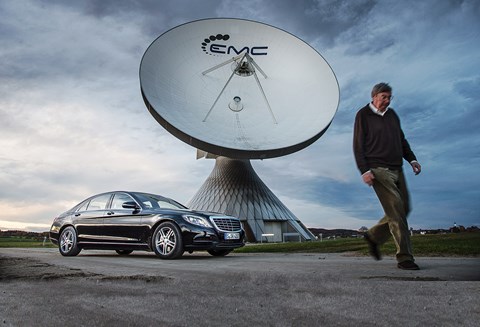► Life with our plug-in hybrid S-class
► Can petrol-electric limo pay its way?
► Georg Kacher’s long-term test diary
Month 10 running a Mercedes S-class plug-in hybrid: the conclusion to our long-term test
There is no denying that a long-wheelbase S-class sends the wrong message to the Save the Whales generation. But even hardcore Greens prick their ears when this 2140kg electroboat glides past them, almost noiselessly, majestic yet earth-friendly. The aha-effect is then confirmed by the full-scale PLUGIN HYBRID farewell lettering on the bootlid. I have learned to read minds in this car, in particular the mimic transition from ‘here comes Kroesus’ to ‘a millionaire with a social streak, good luck to him.’ It’s in town, in E-mode, below 40mph, when what is now sold as 500e makes captain courteous feel most content with himself. After all, he is at the helm of the world’s most environment-friendly luxury car this side of a Tesla Model S charged with CO2-neutral electricity. And yet this can only be the starting point of the e-revolution, a truly admirable effort which is nonetheless counting down the months until it is bettered by the next chapter in the book Modern Alternative Drivetrains.
Life with the most complete Mercedes ever has become kind of a black-and-white routine. The bright side depends on the availability of devices you can plug into. Last December it was no problem to find a free hook-up lot at the airport, shopping mall or public parking. Now, Greater Munich’s entire 220V infrastructure seems to be occupied 24/7. Timing is of the essence, in more ways than one. While 116 electric horses and the instant torque they generate provide plenty of extra punch, when compared to the 70kWh of the most basic all-electric Tesla, the Merc’s 8.7kWh power core can only do so much. Like promise a zero-emission range of 20 miles – which halves as soon as you join the autobahn.
The best hybrid cars and plug-ins
Ready for Charge is the most often displayed icon. When you leave home with a brimmed charge in Hybrid mode, the ever-hungry lithium ion cells await feeding again after 30 miles. Although the V6 petrol engine will do that when you hit the charge button, this defies the purpose and only makes sense when approaching a restricted area like a low-emission city centre. I have a hunch that my big Benz is only an interim solution. Although fairly priced at roughly the same level as the 455bhp S500, the PHEV version is bound to age more quickly due to the fast progress of battery technology, e-motors and performance electronics. Coming soon are smaller, lighter energy packs with shorter charge cycles and EV ranges of, eventually, 60 miles.
Like the S400 mild hybrid before it and the 48V P290 after it, S SK 4207 is thus kind of a time capsule, a production car about to become a piece of auto history. It was sensationally advanced when I first got it, but it will soon be overtaken. Think of it as a smartphone on wheels, best before June 2017 when the facelifted S-class is due. Don’t get me wrong: the white dominates the black. There is always enough AC/DC available in standby mode to out-sprint that 5-series at the lights, but this unique no-noise supremacy, the surprise and delight as you hush past pedestrians, the strong social acceptance fusing with blatant opulence – all these positive impressions last 45 minutes max.
Despite its strengths, I wouldn’t have chosen the S-class; had it been available, I would have opted for the less extrovert C350e. Even so, I do feel a bit like a pioneer now, and I am ready for the next level of electromobility as soon as it becomes available.
I won’t miss the Merc for the stubborn charge cable (which never is quite long enough) or for the complicated controls, but as far as the driver enviroment goes, this is Hermès and Loro Piana combined; those seats are incredible; the Burmester audio is sublime; the optional equipment deserves 11 out of ten on the fancifulness chart.
What’s next in the Kacher garage? Maybe a Jaguar XJ-C V12 resto project, perhaps a used Cayman. Seems that, for the time being, my thirst for ultra high-tech has been quenched.
By Georg Kacher
Month 9 running a Mercedes-Benz S500 PHEV: rough with the smooth
Quite suddenly, the so far faultless transition between fossil-fed and electric propulsion began to shed its inherent smoothness for more agitated manners. Cut-in and cut-out became irritatingly noticeable, throttle response varied from lazy to excited, part-throttle acceleration typically was a double-phased exercise. When I returned the graceful glider to its maker for a check-up, the man in blue smocks nodded knowingly: ‘A software thing.’ Sure enough, flashing the hard drive cured the problem. The only remaining drivetrain-related issue concerns the slow change from forward to reverse which is sudorifically reminiscent of early Ferrari F1 transmissions.
By Georg Kacher
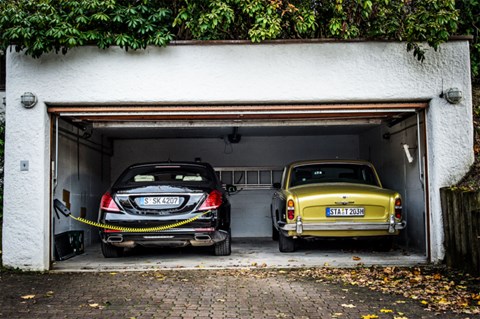
Month 8 running a Mercedes S-class Plug-in Hybrid: what happens when you can’t actually plug it in?
What a month! Stuttgart, Vienna, Stuttgart again, Salzburg. In style and comfort, yes. Stressless, no. It’s holiday season, and German autobahn traffic frequently g-r-i-n-d-s to a halt. Why? Not enough road space for too many vehicles, despite a weekend truck ban and rigorously enforced speed limits. Even when your trip kicks off at 5am, by 9am at the latest the trap will likely click shut – Stau! (the German word for congestion). One of these days we’ll be able to lean back and let the car do the brooding. But this is 2015, and when the on-board chips take over, you will likely be out-flocked left and right at an embarrassing rate. True, the S500 does what it can to support the driver: hold the lane even through mild bends, monitor other vehicles with cameras and proximity sensors, scan the road surface ahead for irregularities and pre-condition the dampers accordingly. It’s all very well, but not quite enough to make you totally feel at ease at a felt average speed of 27mph.
The last four weeks passed with almost no plug-ins. At the airport, the six 220V nozzles were regularly taken. At the hotels in Vienna and Stuttgart, the underground car parks were blatantly devoid of charging stations. In Salzburg, the solitary socket had the wrong format. At home, Zoltan was busy painting the garage. No big deal? Well, in combination with a fair amount of motorway driving, the consumption dropped from 31.3 to 25.5mpg. Not bad for a 442bhp 5250mm 2140kg land yacht. But unexceptional for a plug-in hybrid. To get the best out of this system, you want to travel at a reasonably brisk pace and recharge the batteries via lift-off and braking. At ginger velocities, the black box prioritises e-mode, thereby sucking the lifeblood out of the fully charged energy cells in less than 20 miles. I regularly use e-charge which quickly gets the capacity back up to a level that allows us to cruise through town silently like a majestic black whale.
By Georg Kacher
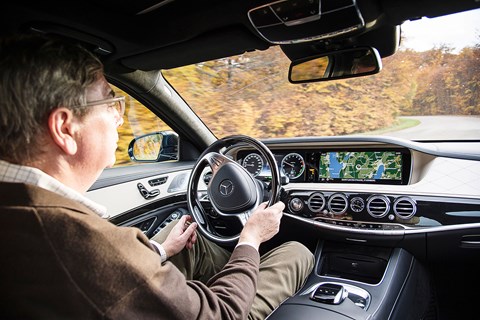
Month 7 running a Merc S500 Plug-in Hybrid: we see the light
It took me four months, but now I’m hooked. With almost missionary enthusiasm, I have become a fuel-saving addict. Plugging in at home and plugging in at the airport reduces the fuel consumption on this 40-mile routine run by over 40%. In money terms, that’s £6 one-way, on par with a Smart Fortwo and much cheaper than the train. Not to mention S-class comfort, music courtesy of Herr Burmester and a much more leisurely pace than all those nine-to-fivers. How much for one battery charge? It’s free at the airport, at home it costs no more than to slow-cook the Sunday roast.
By Georg Kacher
Month 6 running a Mercedes S-class plug-in hybrid: summertime and the living is fast
Summer tyres, at last! Which means no more speed limit when there is no speed limit. And higher cornering speeds. And more cornering grip. Except when I dive deep into the sub-menu to deactivate ESP. You see, there is a business park nearby which works really well as Sunday morning playground. A 63-year-old child? You bet. Surprisingly, the economy does not suffer that badly from full-throttle antics. All it takes is the discipline to hook up Willy the Whale before closing the garage door.
Getting in a flap over these flaps:
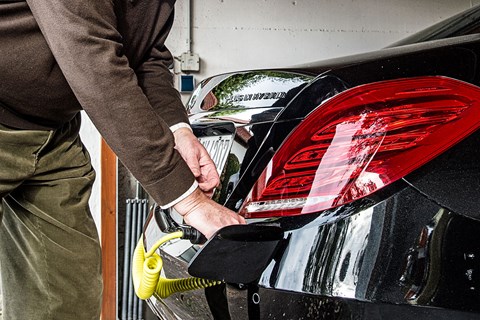
The two sandwich flaps which conceal the plug-in connector socket do annoy me. You see, I keep forgetting to snap them shut after unhooking the charging cable and loading it in the boot. A little warning light would certainly help. Or better still, a self-closing door. Or, of course, a triple-figure IQ.
High-tech drivetrain = 27.6mpg?
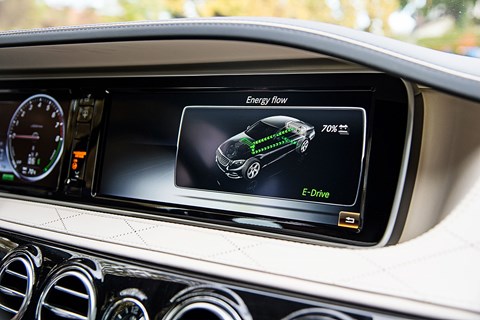
Despite the hybrid package and fancy energy flow graphics, 27.6mpg is not exactly Golf diesel territory. But it includes plenty of 130mph-plus autobahn runs. The S-class’s connectivity, also activated via this screen, isn’t perfect. Activating the phone takes two steps, Apple CarPlay is sorely missed, and the stacked controller-touch pad unit in the centre console requires extra fingers.
Lie back and think of Germany:
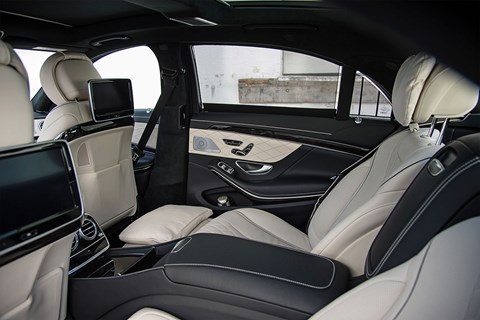
Black paint meets ivory interior. Spot-on for the target audience, too mainstream for GK. The cockpit is as superbly crafted as you’d expect, but almost Maybach-esque in appearance. And the legroom, both front and rear, is astonishing. Makes a good first-class cabin feel like cattle class on Banana Airways. The glass sunroof is vast – it’s a big opening lid complemented by an equally big fixed panel.
By Georg Kacher
Month 5 running a Mercedes S-class plug-in hybrid: what do you do while the car’s parking itself?
Despite its bulk, the S500 is surprisingly easy to manoeuvre around town. When space is really tight – as indicated by an orchestra of warning beeps – the surround-view device helps. One can choose from different angles including close-ups of all four corners and a bird’s-eye perspective which makes you a master of parallel parking.
Of course, fully automatic parking is also available, but I rarely use it. For a start, the system prefers gaps so long that your granny could get into them. In addition, the degree of perfection varies from meticulous to sloppy. Worst of all, I feel like a dork sitting there while the chips do the work. It may only be my bad lip-reading, but bystanders seem to be saying ‘if the rich geezer can’t handle the car, he should swap it for an A-class.’
Ever since the black S-class moved into our garage, it’s received positive comments. The neighbours, who positively hate red test cars brought up from Italy, thank me for using E-mode when departing and arriving. The kid next door earns an extra Euro for washing and hoovering ‘a vehicle the size of a minivan.’ And our friends who have season tickets for the Residenztheater are no longer willing to take turns driving to and from Munich. Which is perfectly understandable when you compare the first-class rear passenger compartment of the S-class with that of their Renault Scenic.
By Georg Kacher
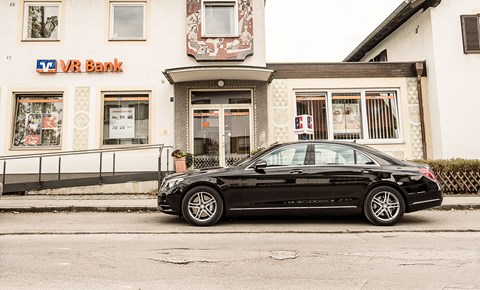
Month 4 running a Mercedes S500 Plug-in Hybrid: tough brakes
The biggest hurdle a hybrid drivetrain must master is the smooth transition between operating modes.
Take the brakes, whose job it is to decelerate and recuperate. The left pedal is commendably intuitive, and it self-actingly increases stopping power just before the vehicle comes to a halt.
But things get trickier when you need ABS; it’s not really compatible with the ability to generate electric energy, pedal travel (long), pedal effort (high) and pedal feel (wooden) don’t synchronise. Also, as the car wants to coast whenever possible, there’s no engine braking, so you find yourself touching the brakes more often.
By Georg Kacher
Month 3 running a Mercedes S500 Plug-in Hybrid: the LED headlamps on test
We’ve got the Intelligent Light System with Night Vision plus, which is great in winter. It employs more than 190 LEDs which vary the depth, width and intensity of illumination. In traffic the headlamps direct light past moving objects and cast far ahead, using the dotted line as a guide. Night Vision’s LED eyes look for pedestrians and animals. When the infrared sensor detects an obstacle, it’s marked red on a pop-up b&w screen. At the same time, a spotlight focuses on the object. Useful in a silent car like this.
In other news, we’ve done 1132 miles this month and our economy stands at 29mpg. No better than a diesel, do you say? More on this crucial element of our S-class plug-in test soon.
By Georg Kacher
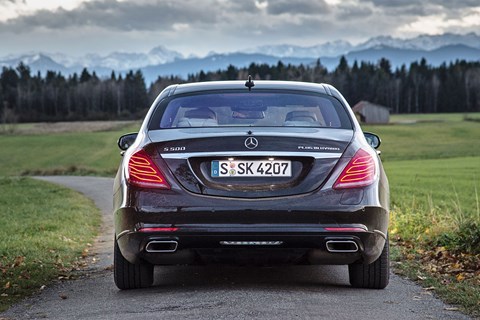
Month 2 running a Mercedes S500 Plug-in Hybrid: advice on options
The Georgehof sits high up on a hill overlooking the Ammersee. It’s a beautiful spot, but to get there you must first master a steep climb which is notoriously slippery in winter. To access home 24/7, four-wheel drive is therefore a big bonus. The S500 PHEV fares better on Our Hill than most rear-wheel-drive cars, but even on brand-new tyres and with that battery pack resting heavily on top of the axle, ice and deep snow can be insurmountable. So I was forced to leave the S500 down in the village for a bit and drive home in our 5-series Touring – with xDrive.
The long-wheelbase S-class is exactly that: long. 5290mm long, to be precise. Which makes it everyone’s favourite choice whenever one of the boys comes home with the girlfriend. Even when the driver’s seat is pushed back almost all the way, there remains enough rear legroom to swing a tiger or two. The front passenger can watch TV or a DVD on the large split-screen display, and there are two colour monitors for the enjoyment of the back-benchers, who can rest their heads on soft Maybach-style leather cushions. The power-operated rear seats, which are separated by a wide centre console, slide forward and recline, and with the front passenger seat in the forwardmost position the chair behind can be converted into a super-comfortable makeshift bed.
Predictably, the car’s considerable length and girth take some getting used to in town and when manoeuvring in confined spaces. To protect its shiny obsidian black livery, our car is fitted with more surveillance cameras than Trafalgar Square, these offering bird view, rear view, front view, and front and rear side views. There are also amber and red warning lights, plus a pair of proximity beepers. Still afraid of threading the mighty Merc into that bonsai gap? Then simply push the P button and it will park itself.
Another welcome extra is the heated steering-wheel – at least in theory. In reality, the optional wood-and-leather helm (typically ice-cold in winter and red hot in summer) warms only the timberless bottom section which contributes less than a third to the total circumference. So be careful when ticking those boxes.
By Georg Kacher
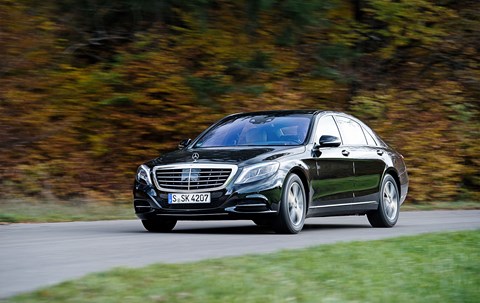
Month 1 running a Merc S-class hybrid: the introduction
The badge on the bootlid reads Mercedes-Benz S500 Plug-in Hybrid. But not for much longer. Since weight and cost are of the essence here, the marketing department will shorten its message to S500e as soon as the supplier can provide that lower-case ‘e’. No other compromises will diminish the big Benz’s overkill opulence which is almost on par with the recently introduced Maybach package.
‘Would you like a down-specced fuel miser with virtually zero extras?’ the man from Merc asked me before specifying the long-termer. ‘Or do you want just about every option there is?’ I pretended I needed some time to ponder, but it was clear from the beginning that only a fully loaded S-class would ever be entitled to drain our personal electrical system until the fish tank went black and the fridge no longer cooled. Which explains our car’s lofty list price of €154,890 (£116,000), a tally which includes £34,000 worth of extras.
The most significant pampering devices fitted are the chauffeur pack (moves the passenger seat all the way forward), sun protection pack (motorised rear-window blinds), keyless go, air balance pack (perfume dispenser in the glovebox), exclusive pack (special leather and wood, even more special stitching and piping), park assistant (brakes and steers for you), rear-seat entertainment with picnic tables, comfort heating (for the steering wheel and both armrests), power-operated first-class rear seats (split by a centre console), heated and ventilated comfort front seats (with inflatable adaptive side bolsters and massage function), panorama sunroof, digital radio, TV tuner, Burmester sound system and automatic air conditioning. Anything missing? Nope. One more thing: the black paint job serves a single purpose, and that is to boost the car’s resale value in a segment where even silver or white are deemed frivolous.
Click here for our Mercedes S500 Plug-in Hybrid review.
I must confess that I am not really an S-class person. The car is too big for my liking, the social acceptance thing can go against one’s grain, and I would only ever travel in the sumptuous rear if they took away my licence. Although I never thought so, I am however very much a hybrid person. Better make that an e-drive addict. Charging is a bore, but wafting along almost silently at up to 80mph makes you feel like a real planet saviour, even if the CO2 footprint of the S500e is not quite as small as that of the C-class PHEV.
Travelling engineless at country road speed there is always enough tyre and wind noise to deter mama deer and Bambi from crossing without looking. In town, however, pedestrians, cyclists and pets tend to interfere with your flightpath at random. Honk, and the alleged rich hooligan will be shown the middle finger; stay quiet and you get the same finger for frightening the wits out of grandma and junior. Perhaps an artificially generated e-tune, like a bonsai tram on tyres, is not such a bad idea?
The mpg and CO2 arithmetics depend on the state of charge. When you leave home with a set of batteries bristling with electricity, and when your driving style is sedate, it is actually possible to average 50, 60, even 70mpg. In ideal conditions (no climbs, no traffic) and on a pussy-footed throttle, 20 miles are the maximum emission-free range. Hooking up to the mains is easier said than done. Since the lidded socket hides in the right corner of the bumper, a plug-in point left of the vehicle is literally s-t-r-e-t-c-h-i-n-g the friendship. Why didn’t they settle for a centre take-off point?
Public charge facilities are even more of a hassle. Only very few stations offer high-voltage energy, and unless you find a parking space close by, neither of the two bright yellow spiral charge cables is quite long enough. If the S500e was to stay at the Georghof for good, a wall box would be a more convenient and much faster option. As it is, the battery pack takes between six and eight hours to get back to form. Watch this space for more electrifying experiences…
By Georg Kacher
